英语听课记录1
- 格式:doc
- 大小:46.00 KB
- 文档页数:6

英语听课记录1(总5页)--本页仅作为文档封面,使用时请直接删除即可----内页可以根据需求调整合适字体及大小--听课记录一:Lesson type: GrammarTeaching objectives: By the end of the lesson, most of the students will be able to…1. Language skills:read the passage and fill in the blanks with modal verbs correctly.2. Language knowledge:understand and use the modal verbs: can, may, must.3. Learning strategies:grasp a language point through summing up the key points in a table.Teaching focus:the understanding of the grammar: modal verbs (can, may, must).Teaching procedure:Step 1 Warming up1. Questions and lead-in: Can Daisy buy a packet of electricity at last (Yes, she can.)2. Brainstorming: Think about as many modal verbs as you can.Step 2 Grammar learning and practicingA. can1. Fill in the table about “can”.2. Make sentences about your special abilities with “I can…”.3. Read the dialogue between Hi and Lo and complete the sentences with “can/ can’t”.B. may1. Read the sentences of “may/ may not”, and fill in the table about “may”.2. Play a game about “may/ may not”.3. Complete the sentences with “may/ may not”.4. Have a role-play using “may/ may not”.C. must1. Read the sentences of “must/ must not”, and fill in the table about “must”.2. (1) Set a scene: Daily saw a doctor and he told her what to do and what not to do. (2) Assign a task: Help Daisy write down the doctor’s instruction with “must/ mustn’t”.3. Play a game about “mustn’t”: What do these sighs mean?4. Make rules with “must n’t” for our class and draw signs.C. Bingo GameStep 3 SummarySum up the grammar.Step 4 HomeworkAssign homework.Advantage and disadvantage:1. Advantages:(1) Great smile on the face.(2) Amiable to the students.2. Disadvantages:(1) Low voice.(2) Fast speed when reading the instructions of the exercise.(3) Unclear instructions.(4) Not funny.(5) Disobedient to the students’ cognitive laws.(6) Poor knowledge of English . the false explanation about“heater”).听课记录二:Lesson type: WritingTeaching objectives: By the end of the lesson, most of the students will be able to…1. Language skills:write a passage on “Cats/ Dogs/ Birds/ …makes the best pet”.2. Language knowledge:(1) understand and grasp the structure of an argumentative.(2) grasp some good expressions in demonstrating one’s opinion such as First, Second, What’s more,etc.3. Learning strategies:Analyze the structure of an argument by finding out its Introduction, Body and Conclusion and the supporting details.Teaching focus:The structure of an argumentative.Teaching procedure:Step 1 Warming up1.Greeting.2.Free talk: What animal do you suggest Tom to buyStep 2 Pre-writing1. Find out the structure of the text learned (Introduction, Body, Conclusion).2. Find out the reason and the supporting details for each paragraph of the body.3. Read another passage and finish the table on P92.4. Summarize the structures and expressions.Step 3 While-writing1. Group work: Discuss and finish the table, then share.2. Individual work: Write a passage on “Cats/ Dogs/ Birds/ …makes the best pet”.Step 4 Post-writing1. Class conferencing2. Pair work: Exchange and correct.Step 5 SummarySum up the structure and expressions of writing.Step 6 HomeworkAssign the homework.Advantage and disadvantage:1. Advantages:(1) Clear structure.(2) Enough interaction with the students.(3) Enough input and output for the students.(4) Amiable to the students.(5) Good oral English.(6) Good basis of English knowledge.2. Disadvantages:(1) Should more smile on the face.(2) Should teacher the students with love.听课记录三:Lesson type: RevisionTeaching objectives: By the end of the lesson, most of the students will be able to…1. Language skills:describe the features of animals such as horse, cat, fish, etc.2. Language knowledge:consolidate the words learned in this unit.3. Affectdevelop the awareness of protecting animals.Teaching focus:the words and features of the animals.Teaching procedure:Step 1 Warming up1. Greeting.2. TPL:(1) Oral instruction: One two three – A B C(2) Reaction: One/ Two/ Three/… - Finger shape(3) Game: Listen and do.3. Sing a song:(1) Set a scene (picture): They are going to Ben’s uncle’s farm.(2) Sing a song: BingoStep 2 Revision1. Let’s spy: What animals can you see (Ss use a piece of paper as a telescope)(1) It has four legs and a long tail: horse.(2) It has a long tail: monkey(3) It has a long nose and big ears: elephant.2. Let’s listen and number.3. Let’s look, read and choose:(1) Set a scene: Suddenly, there is a thunder. The animals hide.(2) Describe: What can you see?*mind map (body): tail(s), leg(s), ear(s), eye(s), mouth(s), nose(s), feet, hair, …(3) Do the exercise: Look, read and choose.(4) Group work: share the answers.4. Let’s sum up:- How many …(s) are there?- There are …/ There is…5. Let’s guess (riddles)(1) cat.(2) dog(3) Show a video: dogs are human’s friends.9. Let’s describe(1) Group work:a. fish: It’s … It’s … It has a short … It has two small eyes.b. chicken: It’s … It’s … It has … It has …c.duck: It’s … It’s … It has … It has …(2) Do the exercise: Read and choose.10. Let’s sum up:- 描述一个时:It has…- 描述两个时:They have…11. Let’s look, say and guess(1) Individual work(2) Pair work: Share and guess.12. Expansion:(1) Pictures of other animals.(2) Video about a pet.(3) Summary Aimals are our friends.Step 3 Self-assessment1. Group work: Discuss and finish the table, then share.2. Individual work: Write a passage on “Cats/ Dogs/ Birds/ …makes the best pet”.Step 4 HomeworkDraw and tell.Advantage and disadvantage:1. Advantages:(1) Funny.(2) Colorful pictures.(3) Good exercise.(4) Good preparation for each part (from language input to output)(5) Strong love for the students.(6) Young heart and positive attitude,2. Disadvantages:Poor oral English.。
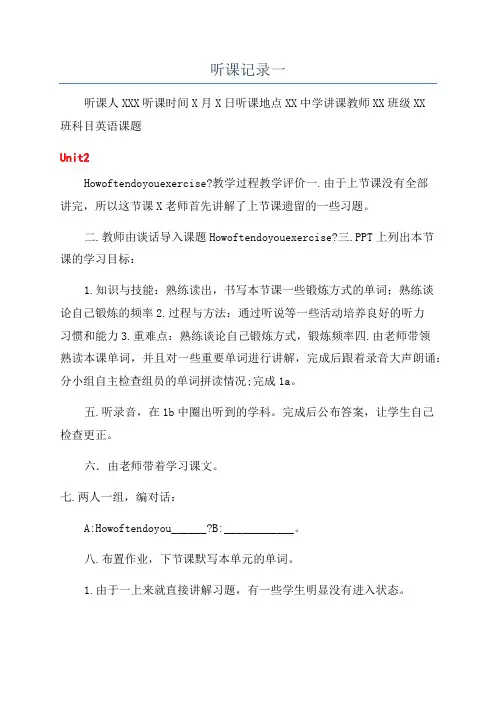
听课记录一听课人XXX听课时间X月X日听课地点XX中学讲课教师XX班级XX班科目英语课题Unit2Howoftendoyouexercise?教学过程教学评价一.由于上节课没有全部讲完,所以这节课X老师首先讲解了上节课遗留的一些习题。
二.教师由谈话导入课题Howoftendoyouexercise?三.PPT上列出本节课的学习目标:1.知识与技能:熟练读出,书写本节课一些锻炼方式的单词;熟练谈论自己锻炼的频率2.过程与方法:通过听说等一些活动培养良好的听力习惯和能力3.重难点:熟练谈论自己锻炼方式,锻炼频率四.由老师带领熟读本课单词,并且对一些重要单词进行讲解,完成后跟着录音大声朗诵:分小组自主检查组员的单词拼读情况;完成1a。
五.听录音,在1b中圈出听到的学科。
完成后公布答案,让学生自己检查更正。
六.由老师带着学习课文。
七.两人一组,编对话:A:Howoftendoyou______?B:____________。
八.布置作业,下节课默写本单元的单词。
1.由于一上来就直接讲解习题,有一些学生明显没有进入状态。
2.重点和难点清晰,学生能够清楚地把握重点,有目的有选择的进行学习。
3.学生自己熟读单词的过程中,老师也会一直注意班内学生的状况,及时为个别学生纠正一些语音错误,也会维护班内的秩序,防止一些学生趁大家读单词的时间说话。
4.让学生自己对话可以让学生对本课内容的重点印象深刻。
总结或建议X老师讲课时,不仅仅是自己讲,而是在课堂之上来调动学生自主学习的积极性,这种方法不仅可以增加学生对知识点的印象,还可以增加学生对课堂的专注度。
中间学生自己朗诵时间感觉过长,一些学生觉得自己已经熟练之后可能就会分心做别的事。
但一个班水平参差不齐,中间自主学习的时间还是要适度把握。
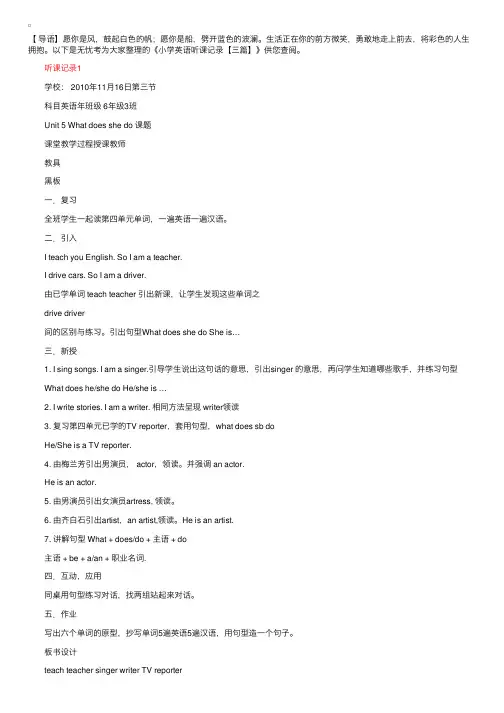
【导语】愿你是风,⿎起⽩⾊的帆;愿你是船,劈开蓝⾊的波澜。
⽣活正在你的前⽅微笑,勇敢地⾛上前去,将彩⾊的⼈⽣拥抱。
以下是⽆忧考为⼤家整理的《⼩学英语听课记录【三篇】》供您查阅。
听课记录1 学校: 2010年11⽉16⽇第三节 科⽬英语年班级 6年级3班 Unit 5 What does she do 课题 课堂教学过程授课教师 教具 ⿊板 ⼀.复习 全班学⽣⼀起读第四单元单词,⼀遍英语⼀遍汉语。
⼆.引⼊ I teach you English. So I am a teacher. I drive cars. So I am a driver. 由已学单词 teach teacher 引出新课,让学⽣发现这些单词之 drive driver 间的区别与练习。
引出句型What does she do She is… 三.新授 1. I sing songs. I am a singer.引导学⽣说出这句话的意思,引出singer 的意思,再问学⽣知道哪些歌⼿,并练习句型 What does he/she do He/she is … 2. I write stories. I am a writer. 相同⽅法呈现 writer领读 3. 复习第四单元已学的TV reporter,套⽤句型,what does sb do He/She is a TV reporter. 4. 由梅兰芳引出男演员, actor,领读。
并强调 an actor. He is an actor. 5. 由男演员引出⼥演员artress, 领读。
6. 由齐⽩⽯引出artist,an artist,领读。
He is an artist. 7. 讲解句型 What + does/do + 主语 + do 主语 + be + a/an + 职业名词. 四.互动,应⽤ 同桌⽤句型练习对话,找两组站起来对话。
五.作业 写出六个单词的原型,抄写单词5遍英语5遍汉语,⽤句型造⼀个句⼦。
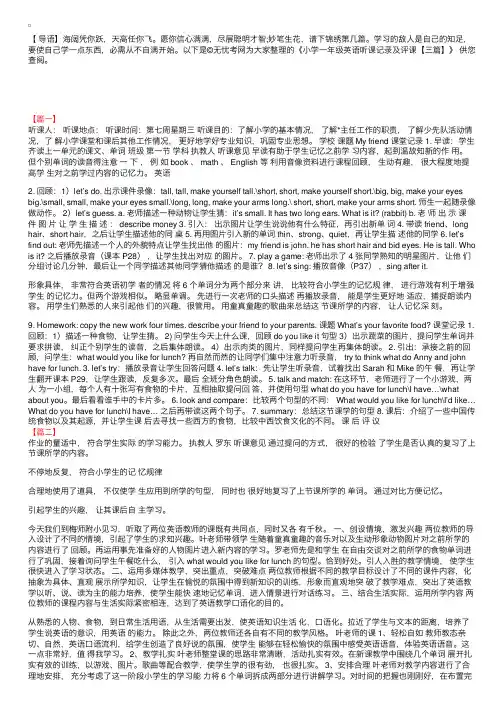
【导语】海阔凭你跃,天⾼任你飞。
愿你信⼼满满,尽展聪明才智;妙笔⽣花,谱下锦绣第⼏篇。
学习的敌⼈是⾃⼰的知⾜,要使⾃⼰学⼀点东西,必需从不⾃满开始。
以下是©⽆忧考⽹为⼤家整理的《⼩学⼀年级英语听课记录及评课【三篇】》供您查阅。
【篇⼀】听课⼈:听课地点:听课时间:第七周星期三听课⽬的:了解⼩学的基本情况,了解*主任⼯作的职责,了解少先队活动情况,了解⼩学课堂和课后其他⼯作情况,更好地学好专业知识,巩固专业思想。
学校课题 My friend 课堂记录 1. 早读:学⽣齐读上⼀单元的课⽂、单词班级第⼀节学科执教⼈听课意见早读有助于学⽣记忆之前学习内容,起到温故知新的作⽤。
但个别单词的读⾳得注意⼀下,例如 book 、 math 、 English 等利⽤⾳像资料进⾏课程回顾,⽣动有趣,很⼤程度地提⾼学⽣对之前学过内容的记忆⼒。
英语2. 回顾:1)let’s do. 出⽰课件录像:tall, tall, make yourself tall.\short, short, make yourself short.\big, big, make your eyes big.\small, small, make your eyes small.\long, long, make your arms long.\ short, short, make your arms short. 师⽣⼀起随录像做动作。
2)let’s guess. a. ⽼师描述⼀种动物让学⽣猜:it’s small. It has two long ears. What is it? (rabbit) b. ⽼师出⽰课件图⽚让学⽣描述: describe money3. 引⼊:出⽰图⽚让学⽣说说他有什么特征,再引出新单词4. 带读 friend、long hair、short hair,之后让学⽣描述他的同桌5. 再⽤图⽚引⼊新的单词 thin、strong、quiet,再让学⽣描述他的同学6. let’s find out: ⽼师先描述⼀个⼈的外貌特点让学⽣找出他的图⽚:my friend is john, he has short hair and bid eyes. He is tall. Who is it? 之后播放录⾳(课本 P28),让学⽣找出对应的图⽚。
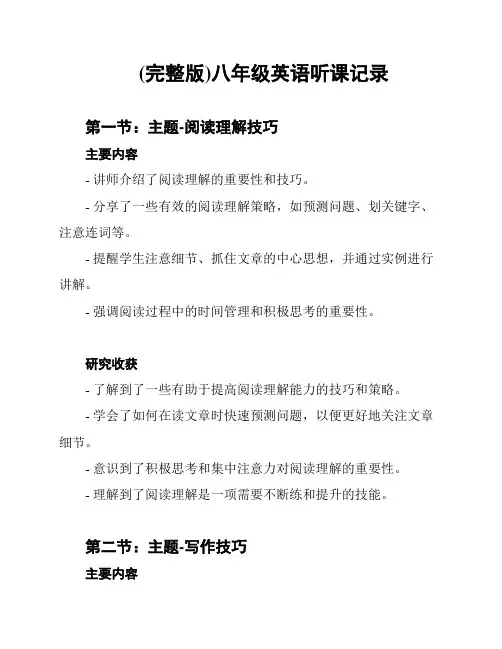
(完整版)八年级英语听课记录第一节:主题-阅读理解技巧主要内容- 讲师介绍了阅读理解的重要性和技巧。
- 分享了一些有效的阅读理解策略,如预测问题、划关键字、注意连词等。
- 提醒学生注意细节、抓住文章的中心思想,并通过实例进行讲解。
- 强调阅读过程中的时间管理和积极思考的重要性。
研究收获- 了解到了一些有助于提高阅读理解能力的技巧和策略。
- 学会了如何在读文章时快速预测问题,以便更好地关注文章细节。
- 意识到了积极思考和集中注意力对阅读理解的重要性。
- 理解到了阅读理解是一项需要不断练和提升的技能。
第二节:主题-写作技巧主要内容- 讲师介绍了写作的基本结构和技巧,如引言、主体段落和结论等。
- 分享了一些有效的写作策略,如提出观点、给出例证、使用合适的过渡词等。
- 强调写作过程中的逻辑思维和清晰表达的重要性,并通过实例进行讲解。
- 提醒学生注意写作时的时间管理和合理组织各段落。
研究收获- 了解到了一些有助于提高写作能力的技巧和策略。
- 学会了如何合理组织文章结构,使其逻辑清晰。
- 理解到了写作中的观点提出和例证给出的重要性。
- 意识到了时间管理和思维清晰表达对写作的重要性。
第三节:主题-口语表达技巧主要内容- 讲师介绍了有效的口语表达技巧,如流利地表达观点、使用恰当的表达方式等。
- 分享了一些提高口语能力的方法,如多听多说、模仿优秀的口语表达等。
- 强调口语表达中的自信和积极思维的重要性,并通过实例进行讲解。
- 提醒学生注意口语练的机会和时间安排。
研究收获- 了解到了一些有助于提高口语表达能力的技巧和策略。
- 学会了如何流利地表达自己的观点,避免口吃和语法错误。
- 意识到了自信和积极思维对口语表达的重要性。
- 理解到了口语表达需要不断练和提升的重要性。
总结这次听课让我收获良多。
通过研究阅读理解技巧、写作技巧和口语表达技巧,我提高了自己的英语能力。
我将会持续练和巩固所学的技巧,以便在英语研究中更加自如和有效地表达自己。

英语听课记录范文(实用6篇)(经典版)编制人:__________________审核人:__________________审批人:__________________编制单位:__________________编制时间:____年____月____日序言下载提示:该文档是本店铺精心编制而成的,希望大家下载后,能够帮助大家解决实际问题。
文档下载后可定制修改,请根据实际需要进行调整和使用,谢谢!并且,本店铺为大家提供各种类型的经典范文,如工作总结、工作计划、合同协议、条据文书、策划方案、句子大全、作文大全、诗词歌赋、教案资料、其他范文等等,想了解不同范文格式和写法,敬请关注!Download tips: This document is carefully compiled by this editor. I hope that after you download it, it can help you solve practical problems. The document can be customized and modified after downloading, please adjust and use it according to actual needs, thank you!Moreover, our store provides various types of classic sample essays for everyone, such as work summaries, work plans, contract agreements, doctrinal documents, planning plans, complete sentences, complete compositions, poems, songs, teaching materials, and other sample essays. If you want to learn about different sample formats and writing methods, please stay tuned!英语听课记录范文(实用6篇)英语听课记录范文第1篇五彩缤纷丰收11、秋天的雨香甜好闻(钥匙)传递信息欢乐听课评析这堂课的板书简明扼要地反映了课文的主要资料,脉络清楚,丰收和欢乐两个词语点明了课文的中心,深化了文章的主题。
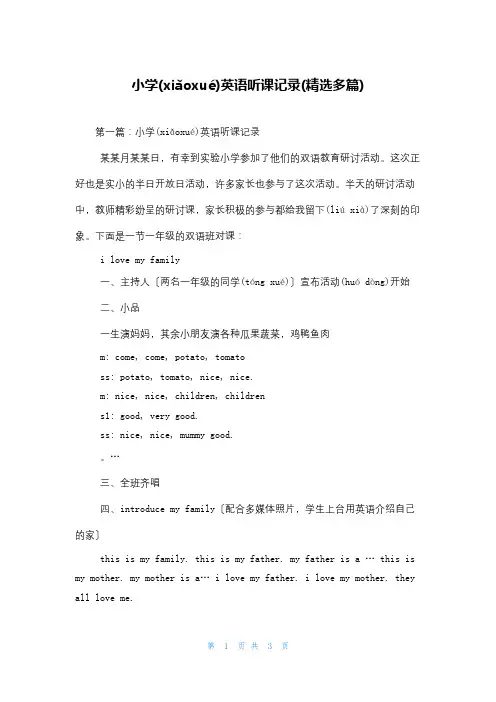
小学(xiǎoxué)英语听课记录(精选多篇)第一篇:小学(xiǎoxué)英语听课记录某某月某某日,有幸到实验小学参加了他们的双语教育研讨活动。
这次正好也是实小的半日开放日活动,许多家长也参与了这次活动。
半天的研讨活动中,教师精彩纷呈的研讨课,家长积极的参与都给我留下(liú xià)了深刻的印象。
下面是一节一年级的双语班对课:i love my family一、主持人〔两名一年级的同学(tóng xué)〕宣布活动(huó dòng)开始二、小品一生演妈妈,其余小朋友演各种瓜果蔬菜,鸡鸭鱼肉m: come, come, potato, tomatoss: potato, tomato, nice, nice.m: nice, nice, children, childrens1: good, very good.ss: nice, nice, mummy good.。
…三、全班齐唱四、introduce my family〔配合多媒体照片,学生上台用英语介绍自己的家〕this is my family. this is my father. my father is a … this is my mother. my mother is a… i love my father. i love my mother. they all love me.五、say a rhymei love my dad, this is my dad. dad, dad, my dad. i love my dad. (mummy)六、dra ail.clean the borad.read a ake acard ,sing a song,send flo id-autumn day5.teach mid-autumn dayread the phrase.s--grouphappy mid-autumn day6.discuss elon,football,head,(shoooncake.do you like itgive the mooncake to ss.12.design a mooncake.give the mooncake to your friends.hello,this is for you.13.teach get an,she can"t get ei typhoon.she can"t get together.can u e ath.c.zhuchen. he is good at chess.d.zhu qinan. he is good at shooting.e.jiang lifu.he is good at math.check the ans ap of ruian r. su"s studentgu chaohao.jiang lifu.gu chaohao is mr su"s stu.某ia 某uanze.c,ho art.he goes to sydney atuch.he goes to paris on his birthday.july 10th noy____is bsmz.ake a album of wenzhounese you know.第五篇:小学4,5年级英语听课记录听课记录听课人:林芸莹,谢玉贞,吴美辉,李敏,谢静雪,邱燕珠听课地点:梅师附小听课时间:第七周星期三听课目的:了解小学的根本情况,了解学习班主任工作的职责,了解少先队活动情况,了解小学课堂和课后其他工作情况,更好地学好专业知识,稳固专业思想。
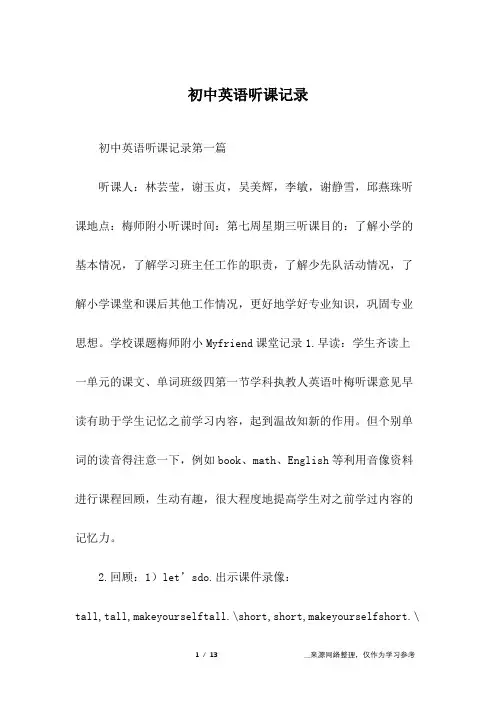
初中英语听课记录初中英语听课记录第一篇听课人:林芸莹,谢玉贞,吴美辉,李敏,谢静雪,邱燕珠听课地点:梅师附小听课时间:第七周星期三听课目的:了解小学的基本情况,了解学习班主任工作的职责,了解少先队活动情况,了解小学课堂和课后其他工作情况,更好地学好专业知识,巩固专业思想。
学校课题梅师附小Myfriend课堂记录1.早读:学生齐读上一单元的课文、单词班级四第一节学科执教人英语叶梅听课意见早读有助于学生记忆之前学习内容,起到温故知新的作用。
但个别单词的读音得注意一下,例如book、math、English等利用音像资料进行课程回顾,生动有趣,很大程度地提高学生对之前学过内容的记忆力。
2.回顾:1)let’sdo.出示课件录像:tall,tall,makeyourselftall.\short,short,makeyourselfshort.\big,big,makeyoureyesbig.\small,small,makeyoureyessmall.\lon g,long,makeyourarmslong.\short,short,makeyourarmsshort.师生一起随录像做动作。
2)let’sguess.a.老师描述一种动物让学生猜:it’ssmall.Ithastwolongears.Whatisit?(rabbit)b.老师出示课件图片让学生描述:describemoney3.引入:出示图片让学生说说他有什么特征,再引出新单词4.带读friend、longhair、shorthair,之后让学生描述他的同桌5.再用图片引入新的单词thin、strong、quiet,再让学生描述他的同学6.let’sfindout:老师先描述一个人的外貌特点让学生找出他的图片:myfriendisjohn,hehasshorthairandbideyes.Heistall.Whoisit?之后播放录音(课本P28),让学生找出对应的图片。
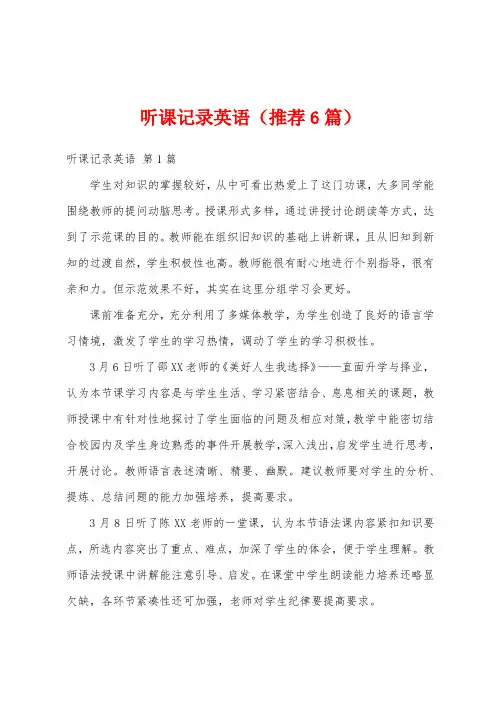
听课记录英语(推荐6篇)听课记录英语第1篇学生对知识的掌握较好,从中可看出热爱上了这门功课,大多同学能围绕教师的提问动脑思考。
授课形式多样,通过讲授讨论朗读等方式,达到了示范课的目的。
教师能在组织旧知识的基础上讲新课,且从旧知到新知的过渡自然,学生积极性也高。
教师能很有耐心地进行个别指导,很有亲和力。
但示范效果不好,其实在这里分组学习会更好。
课前准备充分,充分利用了多媒体教学,为学生创造了良好的语言学习情境,激发了学生的学习热情,调动了学生的学习积极性。
3月6日听了邵XX老师的《美好人生我选择》——直面升学与择业,认为本节课学习内容是与学生生活、学习紧密结合、息息相关的课题,教师授课中有针对性地探讨了学生面临的问题及相应对策,教学中能密切结合校园内及学生身边熟悉的事件开展教学,深入浅出,启发学生进行思考,开展讨论。
教师语言表述清晰、精要、幽默。
建议教师要对学生的分析、提炼、总结问题的能力加强培养,提高要求。
3月8日听了陈XX老师的一堂课,认为本节语法课内容紧扣知识要点,所选内容突出了重点、难点,加深了学生的体会,便于学生理解。
教师语法授课中讲解能注意引导、启发。
在课堂中学生朗读能力培养还略显欠缺,各环节紧凑性还可加强,老师对学生纪律要提高要求。
3月8日听了秦XX老师的《透镜光的折射》一课,认为教师语言表述能力好,课堂讲解层次清晰,注重启发、拓展,教师的基本功扎实,讲解中注重知识的记忆、整理,结合习题在授课中及时巩固,并做到精批精讲,板书相当清晰、规范。
但做为复习课,对学生能力要求可再提高一些,课堂上可适当给予学生互动的空间。
教学重难点突出,板书清晰有条理。
教学步骤设计合理,由浅入深,循序渐进。
教师基本功扎实,知识讲解准确,教学设计合理,始终以学生为主体,自主学习,小组交流讨论,上台交流展示等形式,师生配合默契,取得了较好的学习效果。
听课记录英语第2篇根据四年级学生好奇心浓厚的特点,并根据小学英语中要注意培养学生发散性思维能力,认真观察,注意倾听并能用英语进行简单交流的目的,联系本课特点,从培养的语言能力入手,通过各种方式,运用学生身边的事物,合理地运用语言材料,培养学生的思维与使用英语的能力。
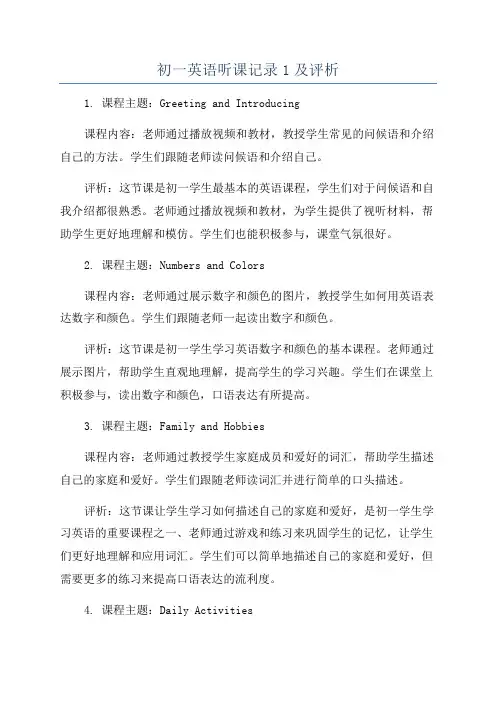
初一英语听课记录1及评析1. 课程主题:Greeting and Introducing课程内容:老师通过播放视频和教材,教授学生常见的问候语和介绍自己的方法。
学生们跟随老师读问候语和介绍自己。
评析:这节课是初一学生最基本的英语课程,学生们对于问候语和自我介绍都很熟悉。
老师通过播放视频和教材,为学生提供了视听材料,帮助学生更好地理解和模仿。
学生们也能积极参与,课堂气氛很好。
2. 课程主题:Numbers and Colors课程内容:老师通过展示数字和颜色的图片,教授学生如何用英语表达数字和颜色。
学生们跟随老师一起读出数字和颜色。
评析:这节课是初一学生学习英语数字和颜色的基本课程。
老师通过展示图片,帮助学生直观地理解,提高学生的学习兴趣。
学生们在课堂上积极参与,读出数字和颜色,口语表达有所提高。
3. 课程主题:Family and Hobbies课程内容:老师通过教授学生家庭成员和爱好的词汇,帮助学生描述自己的家庭和爱好。
学生们跟随老师读词汇并进行简单的口头描述。
评析:这节课让学生学习如何描述自己的家庭和爱好,是初一学生学习英语的重要课程之一、老师通过游戏和练习来巩固学生的记忆,让学生们更好地理解和应用词汇。
学生们可以简单地描述自己的家庭和爱好,但需要更多的练习来提高口语表达的流利度。
4. 课程主题:Daily Activities描述他们的日常活动。
学生们跟随老师一起读词汇并进行口头描述。
评析:这节课学生学习了如何描述他们的日常活动,这是初一学生非常实用的英语课程。
老师通过展示图片和练习,帮助学生更好地理解和记忆词汇,并应用到口语表达中。
学生们能准确地描述自己的日常活动,但需要更多的练习来提高口语表达的流利度。
5. 课程主题:School Subjects课程内容:老师通过教授学生常见的学科词汇,帮助学生描述他们的学科。
学生们跟随老师一起读词汇并进行简单的口头描述。
评析:这节课学生学习了如何描述他们的学科,这是初一学生的必修课程。

2016小学英语听课记录20篇篇一:听课记录篇二:听课记录听课记录时间:2016-3-16下午地点:南阳市第六小学电教室授课教师:陈延晓参与人员:张梁、刘英芬授课内容:Module 5 Unit 1 This is our teacher教学过程:一、Warm-up1. A song2.TPR: Point to your desk/chair…二、Presentation1.看屏幕,提问:今天Lingling向我们介绍了什么,看录像:This is our….2.Daming向妈妈介绍了什么呢,看录像:大明向妈妈介1绍学校的情形。
师提问:大明向妈妈介绍了什么,通过学生的回答引出词汇teacher,教学,出示多个教师照片练习teacher一词。
师再提问:老师是如何评价大明的,Daming isa good child.引出词汇child,教学新词。
(teacher一词的练习方式值得学习,不是单纯地领读单词,而是用多个老师的照片来练习,实际上是一种简单的应用练习)3.Listen, point and find “This is …”(课本第26页)让学生上讲台上的电子白板上圈(电子白板很实用,什么时候莱西能够普及,期待~)4.Listen, point and repeat.教师点白板,播放录音,学生模仿跟读。
跟两遍。
(第一遍后有评价和对第二遍的要求,很好的做法。
)5.小结:师提问:刚才大明是怎样介绍自己的学校的,小组讨论一下。
生:This is our classroom.教师在电子白板上出示This is our classroom.及相应的图画,红色标出This is。
T:Let’s go on.出示And this is our teacher, Ms. Smart.重点标出our。
This is my desk.重点标出my.(用红色标出重点词句,能够引起学生的注意,很好的做法。
)三、Consolidation1.教师让学生看黑板,把刚才板书的内容领读一遍。
英语听课记录及评析范文5篇英语课程的学习其实考的更多的就是单词的记忆和句型的变换,很多英语老师的上课方式或许是有好的地方,但是这不好的地方也是有的,就看看听课的老师是怎么说的吧。
英语听课记录及评析1听课人:xx授课教师李xx授课班级高一(1)班教学内容:unit 4 earthquakes period 4 listening课堂记录step 1 revision1. check the homework exercises.2. ask some students to make sentences with attributive clauses.step 2 warming uptell the students: as we all know, earthquakes are disasters to everyone. but why do earthquakes happen? can we avoid or at least reduce the losscaused by earthquakes? can we foretell earthquakes? now we will do some listening and the listening text will tell us the answers.step 3 listening (on page 62 in the workbook)1. look through the part listening on page 62 and guess what the listening material may be about. then listen to the tape for the first time to see whether their guessing is right or not.2. read the following statements and listen to the tape for the second time. then decide whether they are true or false.check the answers and try to correct the statements which are false.3. listen to the tape again and then answer the questions and complete the following sentences.part 1:1)why do earthquakes happen?2)why do california, china and japan have a lot of earthquakes?part 2:1)do not built______________.2)make sure youbuild______________.3)youmust______________._____________ buildings will fall downand_____________ onesmay______________.a few minutes later, check the answers with the whole class.4. discuss this question in small groups: why do some earthquakes kill more people than others?5. reading and retellingshow the students the listening text and let them read it. then ask them to retell the cause of earthquakes and the ways of reducing losses from earthquakes.step 4 listening task(on page 66 in the workbook)turn to page 66. look at the pictures and discuss what the might have learned.1. in four let the students discuss what would be the best way to protect oneself if there was an earthquake.2. ask one member of the group to give their ideas to the class.3. let the class 出现恶意脚本uate each groups idea and see if they agree. if they do, write the idea on the board. collect the ideas all the groups have contributed.4. ask the students to choose the three that they think are the most useful if an earthquake comes.5. listen to the tape for the first time and see if the ideas on the tape are the same. discuss why the plans on the tape are different from the onessuggested by the class.6. now make the earthquake plan. then listen to the tape for the second time to improve the earthquake plan.step 5 listening(on page 31 in using language)1. tell the students: we are going to listen to a story told by a man who was a survivor of the great san francisco earthquake of 1906.2. go through the sentences in exercise 2, then listen to the tape for the first time, and try to tell whether the statements are true or false.3. go through the questions in exercise 3, then listen to the tape for the second time and answer the questions.4. tell the students: while listening to the tape, you should not only pay attention to the contents, but also the pronunciation and intonation.5. reading and retellingshow the students the listening text and let them read it. then ask them to retell it. step 6 homework1. finish off the workbook exercises.2. read the listening texts again and try to retell them.听课评析本堂课是该单元教学的第四部分听力教学。
英语听课记录及评析范文5篇1. Topic: American History- The professor discussed the American Civil War and its impact on the country. He highlighted the key events and figures that shaped this period in history, such as Abraham Lincoln and the Emancipation Proclamation.- Analysis: The lecture was comprehensive and provided a good overview of the American Civil War. It effectively conveyed the significance of this event in shaping the nation's history.2. Topic: Environmental Science- The lecture focused on the impact of climate change on biodiversity and ecosystems. The professor emphasized the need for conservation efforts and the role of various stakeholders in protecting the environment.- Analysis: The lecture effectively conveyed the urgency of addressing climate change and its impact on the environment. It provided insight into the practical stepsthat can be taken to mitigate these effects.3. Topic: International Economics- The lecture discussed the concept of globalization and its impact on trade and investment. The professor explained the benefits and challenges of global economic integration, citing examples from different countries.- Analysis: The lecture provided a clear understanding of globalization and its implications for international economics. It effectively highlighted both the positive and negative aspects of this phenomenon.4. Topic: Literature- The class focused on analyzing the themes and characters in a classic novel. The professor guided thestudents through a close reading of the text, highlighting key passages and their significance to the overall narrative.- Analysis: The lecture encouraged critical thinking and deeper engagement with the literary work. It provided valuable insights into the nuances of the novel and its underlying themes.5. Topic: Psychology- The lecture discussed the principles of cognitive development in childhood. The professor outlined the key stages of cognitive growth and the factors that influence the maturation of a child's thinking processes.- Analysis: The lecture provided a comprehensive overview of cognitive development in children. It effectively explained the theoretical framework and its practical implications for understanding human behavior.。
英语听课评课记录范文(必备15篇)(经典版)编制人:__________________审核人:__________________审批人:__________________编制单位:__________________编制时间:____年____月____日序言下载提示:该文档是本店铺精心编制而成的,希望大家下载后,能够帮助大家解决实际问题。
文档下载后可定制修改,请根据实际需要进行调整和使用,谢谢!并且,本店铺为大家提供各种类型的经典范文,如工作总结、工作计划、合同协议、条据文书、策划方案、句子大全、作文大全、诗词歌赋、教案资料、其他范文等等,想了解不同范文格式和写法,敬请关注!Download tips: This document is carefully compiled by this editor. I hope that after you download it, it can help you solve practical problems. The document can be customized and modified after downloading, please adjust and use it according to actual needs, thank you!Moreover, our store provides various types of classic sample essays for everyone, such as work summaries, work plans, contract agreements, doctrinal documents, planning plans, complete sentences, complete compositions, poems, songs, teaching materials, and other sample essays. If you want to learn about different sample formats and writing methods, please stay tuned!英语听课评课记录范文(必备15篇)英语听课评课记录范文第1篇随着学科领域整体改革的深入发展,英语课堂教学也发生可喜的变革。
三上英语听课记录unit1
在三上英语的第一个单元中,我们学习了许多有趣的内容。
首先,我们学习了一些基本的问候用语和介绍自己的方式。
老师教给了我们一些常用的英语口语,比如“Hello, my name is...”、“Nice to meet you.”等等。
这些句子在日常生活中非常有用,我们可以用它们来与外国人交流,也可以用它们来自我介绍。
除了基本的问候用语和自我介绍,我们还学习了一些关于家庭和朋友的词汇和句子。
我们学会了用英语来描述家庭成员,比如“father”、“mother”、“sister”、“brother”等等。
我们还学会了用英语来描述朋友,比如“friend”、“classmate”等等。
这些词汇和句子让我们能够更好地描述我们的家庭和朋友,也能够更好地与他人交流。
除了以上内容,我们还学习了一些关于日常活动和爱好的词汇和句子。
我们学会了用英语来描述我们喜欢做的事情,比如“play football”、“read books”、“listen to music”等等。
这些词汇和句子让我们能够更好地表达自己的兴趣爱好,也能够更好地了解他人的生活。
总的来说,三上英语的第一个单元内容丰富多彩,让我们学到了很多有用的知识。
通过学习这些内容,我们不仅能够更好地与外国人交流,也能够更好地了解他人的生活和兴趣爱好。
希望在接下来的学习中,我们能够继续努力,掌握更多的英语知识。
英语听评课记录英语听评课记录。
英语听评课记录篇一:英语学科听评课记录英语学科听评课记录风光小学孙一 2006年12月14日听评课记录听课时间:2006年12月4日班级:三年三班教者:王锐学科:英语课题:Module 9 Unit 1 课堂记实:一、Greeting 二、Sing a song 三、Watch TV Revie some ords: sing dance sim jump far……. 四、Ask a question What can you do? Students anser: I can dance/sing/sim……五、What are Sam and Daming going to do on Sports Day? 六、Listen to the tape and underline“going to” I’m going to do long jump. Sports Day, high jump, run a race 七、Listen, point and repeat Read the sentences one by one and translate them. 八、Make up some sentences ith“I’m going to……” One anser and together 九、Teacher ask: What are you going to do on Sports Day? 十、Read the text four by four in different roles. 十一、Open exercise books: Listen and match.. 十二、Today’s homeork.:Recite the text and revie the ords. 小结:上课开始欢乐的歌曲伴奏,使学生在歌曲中快乐的说英语,在教学过程中,充满亲和力的语言教学,让学生们感到很轻松,没有紧张感,大面积的提问,使全体同学都有说英语的机会,作业的布置让学生课后仍能练习说英语,课上能自然的导入新知,学生在课堂上听说读写都得到训练,让学生从听入手,并提出问题,让学生有目的的去听,课堂教学设计连贯,师生互动很好,教师能充分调动学生学习热情和兴趣,新知引入自然顺畅,学生能很好地进入学习状态。
英语听课记录1听课记录一:Lesson type: GrammarTeaching objectives: By the end of the lesson, most of the students will be able to…1. Language skills:read the passage and fill in the blanks with modal verbs correctly.2. Language knowledge:understand and use the modal verbs: can, may, must.3. Learning strategies:grasp a language point through summing up the key points in a table. Teaching focus:the understanding of the grammar: modal verbs (can, may, must).Teaching procedure:Step 1 Warming up1. Questions and lead-in: Can Daisy buy a packet of electricity at last? (Yes, she can.)2. Brainstorming: Think about as many modal verbs as you can.Step 2 Grammar learning and practicingA. can1. Fill in the table about “can”.2. Make sentences about your special abilities with “I can…”.3. Read the dialogue between Hi and Lo and complete the sentences with “can/ can’t”.B. may1. Read the sentences of “may/ may not”, and fill in the table about “may”.2. Play a game about “may/ may not”.3. Complete the sentences with “may/ may not”.4. Have a role-play using “may/ may not”.C. must1. Read the sentences of “must/ must not”, and fill in the table about “must”.2. (1) Set a scene: Daily saw a doctor and he told her what to do and what not to do. (2) Assign a task: Help Daisy write down the doctor’s instruction with “must/ mustn’t”.3. Play a game about “mustn’t”: What do these sighs mean?4. Make rules with “must n’t” for our class and draw signs.C. Bingo GameStep 3 SummarySum up the grammar.Step 4 HomeworkAssign homework.Advantage and disadvantage:1. Advantages:(1) Great smile on the face.(2) Amiable to the students.2. Disadvantages:(1) Low voice.(2) Fast speed when reading the instructions of the exercise.(3) Unclear instructions.(4) Not funny.(5) Disobedient to the students’ cognitive laws.(6) Poor knowledge of English (e.g. the false explanation about “heater”).听课记录二:Lesson type: WritingTeaching objectives: By the end of the lesson, most of the students will be able to…1. Language skills:write a passage on “Cats/ Dogs/ Birds/ …makes the best pet”.2. Language knowledge:(1) understand and grasp the structure of an argumentative.(2) grasp some good expressions in demonstrating one’s opinion such as First, Second, What’s more,etc.3. Learning strategies:Analyze the structure of an argument by finding out its Introduction, Body and Conclusion and the supporting details.Teaching focus:The structure of an argumentative.Teaching procedure:Step 1 Warming up1.Greeting.2.Free talk: What animal do you suggest Tom to buy?Step 2 Pre-writing1. Find out the structure of the text learned (Introduction, Body, Conclusion).2. Find out the reason and the supporting details for each paragraph of the body.3. Read another passage and finish the table on P92.4. Summarize the structures and expressions.Step 3 While-writing1. Group work: Discuss and finish the table, then share.2. Individual work: Write a passage on “Cats/ Dogs/ Birds/ …makes the best pet”.Step 4 Post-writing1. Class conferencing2. Pair work: Exchange and correct.Step 5 SummarySum up the structure and expressions of writing.Step 6 HomeworkAssign the homework.Advantage and disadvantage:1. Advantages:(1) Clear structure.(2) Enough interaction with the students.(3) Enough input and output for the students.(4) Amiable to the students.(5) Good oral English.(6) Good basis of English knowledge.2. Disadvantages:(1) Should more smile on the face.(2) Should teacher the students with love.听课记录三:Lesson type: RevisionTeaching objectives: By the end of the lesson, most of the students will be able to…1. Language skills:describe the features of animals such as horse, cat, fish, etc.2. Language knowledge:consolidate the words learned in this unit.3. Affectdevelop the awareness of protecting animals.Teaching focus:the words and features of the animals.Teaching procedure:Step 1 Warming up1. Greeting.2. TPL:(1) Oral instruction: One two three – A B C(2) Reaction: One/ Two/ Three/… - Finger shape(3) Game: Listen and do.3. Sing a song:(1) Set a scene (picture): They are going to Ben’s uncle’s farm.(2) Sing a song: BingoStep 2 Revision1. Let’s spy: What animals can you see? (Ss use a piece of paper as a telescope)(1) It has four legs and a long tail: horse.(2) It has a long tail: monkey(3) It has a long nose and big ears: elephant.2. Let’s listen and number.3. Let’s look, read and choose:(1) Set a scene: Suddenly, there is a thunder. The animals hide.(2) Describe: What can you see?*mind map (body): tail(s), leg(s), ear(s), eye(s), mouth(s), nose(s), feet, hair, …(3) Do the exercise: Look, read and choose.(4) Group work: share the answers.4. Let’s sum up:- How many …(s) are there?- There are …/ There is…5. Let’s guess (riddles)(1) cat.(2) dog(3) Show a video: dogs are human’s friends.9. Let’s describe(1) Group work:a. fish: It’s … It’s … It has a short … It has two small eyes.b. chicken: It’s … It’s … It has … It has …c. duck: It’s … It’s … It has … It has …(2) Do the exercise: Read and choose.10. Let’s sum up:- 描述一个时:It has…- 描述两个时:They have…11. Let’s look, say and guess(1) Individual work(2) Pair work: Share and guess.12. Expansion:(1) Pictures of other animals.(2) Video about a pet.(3) Summary Aimals are our friends.Step 3 Self-assessment1. Group work: Discuss and finish the table, then share.2. Individual work: Write a passage on “Cats/ Dogs/ Birds/ …makes the best pet”.Step 4 HomeworkDraw and tell.Advantage and disadvantage:1. Advantages:(1) Funny.(2) Colorful pictures.(3) Good exercise.(4) Good preparation for each part (from language input to output)(5) Strong love for the students.(6) Young heart and positive attitude,2. Disadvantages:Poor oral English.。